Do you have a question about the Garmin Instinct 2 Solar and is the answer not in the manual?
Details about the device's physical layout, buttons, and controls.
Instructions on how to charge the device using a USB cable.
Steps to connect the device to a smartphone via Bluetooth.
Information on how to update the device's software.
Guide for installing and setting up Garmin Express on a computer.
Guide on how to begin tracking a sports or fitness activity.
Advice for ensuring accurate recording of activity data.
Procedures for ending and saving or discarding an activity.
Steps to create and save personalized activity profiles.
How to use the device for indoor training activities.
Instructions to improve treadmill distance accuracy.
Information on using the device for outdoor activities like running and cycling.
How to view recorded downhill skiing or snowboarding run details.
Using audible tones to maintain a consistent training pace.
Guidance for using the device for swimming activities.
Definitions of terms used in swimming activities.
How to use and interpret the device's built-in heart rate monitor.
Proper placement of the device for accurate heart rate readings.
Troubleshooting steps if heart rate data is inconsistent.
How to access and view heart rate data on the device.
Sharing heart rate data with other compatible Garmin devices.
How to disable the wrist-based heart rate monitoring.
Configuring personal details for accurate training data.
Understanding how heart rate zones aid fitness improvement.
Explanation of heart rate zones and their importance in training.
How to configure personalized heart rate zones.
Features for monitoring daily activity metrics.
How the device automatically sets daily step goals.
Reminders to stay active and avoid sedentary periods.
How the device monitors sleep patterns and quality.
Automatic detection and recording of sleep data.
How to silence notifications and alerts.
Tracking moderate to vigorous activity time for health goals.
How intensity minutes are calculated and earned.
Automatic detection of common activity types.
Options to configure activity tracking features.
How to download and perform workouts from Garmin Connect.
Steps to begin a downloaded workout.
Using the device's training calendar synced from Garmin Connect.
How to download and follow training plans.
Creating and performing interval training sessions.
Steps to design custom interval workouts.
How to begin a previously created interval workout.
Procedures for ending an interval workout.
Using the Virtual Partner feature for training.
Setting goals for distance, time, pace, or speed.
How to abort a set training target.
Competing against a past recorded or downloaded activity.
Viewing and managing personal best achievements.
Resetting a record to its previous state.
Deleting a single personal record.
Deleting all personal records for a specific sport.
How to set and configure alarms on the device.
Instructions for using the countdown timer function.
How to operate the device's stopwatch.
Marking and storing current GPS coordinates.
Modifying names, elevations, or positions of saved locations.
Accessing sensor data displays.
Creating a new location by projecting from a known point.
How to find and follow a route to a chosen destination.
Designing and navigating custom routes.
Quickly saving current location and navigating back.
Pointing the device at an object to navigate towards it.
Returning to the origin point of an activity.
Retracing the path of a previous activity.
Procedures for ending an active navigation session.
Measuring the area enclosed by a walked path.
Accessing and viewing past activities and recorded data.
Analyzing heart rate distribution during activities.
Reviewing accumulated distance and time data.
Viewing total distance, elevation, and activity time.
Transferring activities between Garmin devices and the account.
Procedures for removing activity data from the device.
Setting up and managing smartphone notifications.
How to access and read incoming notifications.
Customizing which notifications appear on the device.
Disabling the device's Bluetooth wireless connection.
Configuring alerts for smartphone connection status.
Using the device to find a misplaced smartphone.
Overview of the Garmin Connect platform for tracking and analysis.
Overview of available glanceable information widgets.
Reordering, adding, or removing widgets from the loop.
Controlling an inReach device from the Instinct.
Controlling a VIRB action camera.
Managing the camera during an active session.
Customizing settings for specific activity types.
Configuring and calibrating the compass.
Adjusting and calibrating the altimeter.
Manually calibrating the barometric altimeter.
Configuring and calibrating the barometer.
Manually calibrating the barometer.
Customizing the appearance of maps.
Creating custom alerts for activities.
Setting the display language for the device.
Adjusting time settings like format and timezone.
Configuring backlight timeout, brightness, and gesture.
Adjusting device sounds like key tones and alerts.
Silencing notifications and alerts during specific times.
Assigning shortcuts to device keys.
Locking device keys automatically to prevent accidental presses.
Customizing units of measure for various metrics.
Setting general preferences for pace, speed, and time.
Choosing how activity data is recorded (Smart vs. Every Second).
Setting device mode when connected to a computer.
Restoring the device to factory default settings.
Installing software updates via Garmin Express.
Choosing between 12-hour, 24-hour, or military time format.
Setting the device's time zone.
Setting hourly, sunrise, and sunset alerts.
Manually syncing time with GPS for accuracy.
Backlight behavior during an activity.
Backlight behavior when not in an activity.
Turning on backlight for key presses.
Turning on backlight for alerts.
Turning on backlight via wrist gesture.
Setting backlight duration before it turns off.
Adjusting the backlight's intensity.
Customizing the function of device keys.
Choosing the type of measurement to customize.
Setting the specific unit for a measurement type.
Accessing unit ID, software version, and license details.
Accessing electronic regulatory and compliance markings.
Connecting ANT+ or Bluetooth sensors to the device.
Using sensors for bike speed and cadence data.
Using a foot pod for pace and distance tracking.
Enhancing foot pod speed and distance accuracy.
Manually adjusting foot pod calibration factor.
Configuring foot pod data use over GPS.
Using an ANT+ temperature sensor for ambient readings.
Instructions for cleaning the device to prevent corrosion.
How to replace the device's watch bands.
How to change the device's display language.
Checking smartphone compatibility for Bluetooth features.
Troubleshooting steps for Bluetooth connection issues.
Guidance on using Bluetooth sensors with the device.
Steps to power cycle the device.
Restoring the device to factory default settings.
How the device acquires GPS signals for location services.
Tips to enhance GPS signal acquisition.
Troubleshooting inaccurate temperature readings.
Adjusting backlight settings to save power.
Lowering brightness to extend battery life.
Utilizing UltraTrac for extended battery life during activities.
Disabling Bluetooth when not in use to conserve battery.
Pausing activities for longer periods to save battery.
Disabling activity tracking features to reduce power consumption.
Selecting static watch faces to conserve battery.
Reducing battery drain from notifications.
Disabling heart rate broadcasting to save battery.
Disabling wrist-based HR to conserve battery.
Troubleshooting missing daily step counts.
Tips for improving step count accuracy.
Resolving discrepancies between device and app step counts.
Troubleshooting inaccurate floor climb data.
Understanding when intensity minutes are being earned.
Table mapping tire sizes to corresponding wheel circumferences.
Details about the device's physical layout, buttons, and controls.
Instructions on how to charge the device using a USB cable.
Steps to connect the device to a smartphone via Bluetooth.
Information on how to update the device's software.
Guide for installing and setting up Garmin Express on a computer.
Guide on how to begin tracking a sports or fitness activity.
Advice for ensuring accurate recording of activity data.
Procedures for ending and saving or discarding an activity.
Steps to create and save personalized activity profiles.
How to use the device for indoor training activities.
Instructions to improve treadmill distance accuracy.
Information on using the device for outdoor activities like running and cycling.
How to view recorded downhill skiing or snowboarding run details.
Using audible tones to maintain a consistent training pace.
Guidance for using the device for swimming activities.
Definitions of terms used in swimming activities.
How to use and interpret the device's built-in heart rate monitor.
Proper placement of the device for accurate heart rate readings.
Troubleshooting steps if heart rate data is inconsistent.
How to access and view heart rate data on the device.
Sharing heart rate data with other compatible Garmin devices.
How to disable the wrist-based heart rate monitoring.
Configuring personal details for accurate training data.
Understanding how heart rate zones aid fitness improvement.
Explanation of heart rate zones and their importance in training.
How to configure personalized heart rate zones.
Features for monitoring daily activity metrics.
How the device automatically sets daily step goals.
Reminders to stay active and avoid sedentary periods.
How the device monitors sleep patterns and quality.
Automatic detection and recording of sleep data.
How to silence notifications and alerts.
Tracking moderate to vigorous activity time for health goals.
How intensity minutes are calculated and earned.
Automatic detection of common activity types.
Options to configure activity tracking features.
How to download and perform workouts from Garmin Connect.
Steps to begin a downloaded workout.
Using the device's training calendar synced from Garmin Connect.
How to download and follow training plans.
Creating and performing interval training sessions.
Steps to design custom interval workouts.
How to begin a previously created interval workout.
Procedures for ending an interval workout.
Using the Virtual Partner feature for training.
Setting goals for distance, time, pace, or speed.
How to abort a set training target.
Competing against a past recorded or downloaded activity.
Viewing and managing personal best achievements.
Resetting a record to its previous state.
Deleting a single personal record.
Deleting all personal records for a specific sport.
How to set and configure alarms on the device.
Instructions for using the countdown timer function.
How to operate the device's stopwatch.
Marking and storing current GPS coordinates.
Modifying names, elevations, or positions of saved locations.
Accessing sensor data displays.
Creating a new location by projecting from a known point.
How to find and follow a route to a chosen destination.
Designing and navigating custom routes.
Quickly saving current location and navigating back.
Pointing the device at an object to navigate towards it.
Returning to the origin point of an activity.
Retracing the path of a previous activity.
Procedures for ending an active navigation session.
Measuring the area enclosed by a walked path.
Accessing and viewing past activities and recorded data.
Analyzing heart rate distribution during activities.
Reviewing accumulated distance and time data.
Viewing total distance, elevation, and activity time.
Transferring activities between Garmin devices and the account.
Procedures for removing activity data from the device.
Setting up and managing smartphone notifications.
How to access and read incoming notifications.
Customizing which notifications appear on the device.
Disabling the device's Bluetooth wireless connection.
Configuring alerts for smartphone connection status.
Using the device to find a misplaced smartphone.
Overview of the Garmin Connect platform for tracking and analysis.
Overview of available glanceable information widgets.
Reordering, adding, or removing widgets from the loop.
Controlling an inReach device from the Instinct.
Controlling a VIRB action camera.
Managing the camera during an active session.
Customizing settings for specific activity types.
Configuring and calibrating the compass.
Adjusting and calibrating the altimeter.
Manually calibrating the barometric altimeter.
Configuring and calibrating the barometer.
Manually calibrating the barometer.
Customizing the appearance of maps.
Creating custom alerts for activities.
Setting the display language for the device.
Adjusting time settings like format and timezone.
Configuring backlight timeout, brightness, and gesture.
Adjusting device sounds like key tones and alerts.
Silencing notifications and alerts during specific times.
Assigning shortcuts to device keys.
Locking device keys automatically to prevent accidental presses.
Customizing units of measure for various metrics.
Setting general preferences for pace, speed, and time.
Choosing how activity data is recorded (Smart vs. Every Second).
Setting device mode when connected to a computer.
Restoring the device to factory default settings.
Installing software updates via Garmin Express.
Choosing between 12-hour, 24-hour, or military time format.
Setting the device's time zone.
Setting hourly, sunrise, and sunset alerts.
Manually syncing time with GPS for accuracy.
Backlight behavior during an activity.
Backlight behavior when not in an activity.
Turning on backlight for key presses.
Turning on backlight for alerts.
Turning on backlight via wrist gesture.
Setting backlight duration before it turns off.
Adjusting the backlight's intensity.
Customizing the function of device keys.
Choosing the type of measurement to customize.
Setting the specific unit for a measurement type.
Accessing unit ID, software version, and license details.
Accessing electronic regulatory and compliance markings.
Connecting ANT+ or Bluetooth sensors to the device.
Using sensors for bike speed and cadence data.
Using a foot pod for pace and distance tracking.
Enhancing foot pod speed and distance accuracy.
Manually adjusting foot pod calibration factor.
Configuring foot pod data use over GPS.
Using an ANT+ temperature sensor for ambient readings.
Instructions for cleaning the device to prevent corrosion.
How to replace the device's watch bands.
How to change the device's display language.
Checking smartphone compatibility for Bluetooth features.
Troubleshooting steps for Bluetooth connection issues.
Guidance on using Bluetooth sensors with the device.
Steps to power cycle the device.
Restoring the device to factory default settings.
How the device acquires GPS signals for location services.
Tips to enhance GPS signal acquisition.
Troubleshooting inaccurate temperature readings.
Adjusting backlight settings to save power.
Lowering brightness to extend battery life.
Utilizing UltraTrac for extended battery life during activities.
Disabling Bluetooth when not in use to conserve battery.
Pausing activities for longer periods to save battery.
Disabling activity tracking features to reduce power consumption.
Selecting static watch faces to conserve battery.
Reducing battery drain from notifications.
Disabling heart rate broadcasting to save battery.
Disabling wrist-based HR to conserve battery.
Troubleshooting missing daily step counts.
Tips for improving step count accuracy.
Resolving discrepancies between device and app step counts.
Troubleshooting inaccurate floor climb data.
Understanding when intensity minutes are being earned.
Table mapping tire sizes to corresponding wheel circumferences.
| Display type | Digital |
|---|---|
| Color display | No |
| Display diagonal | - \ |
| Display resolution | 176 x 176 pixels |
| Display size (HxV) | 23 x 23 mm |
| Display technology | MIP |
| Shape | Round |
| Band size | One Size |
| Band color | Black |
| Band material | Silicone |
| Watch case size | 45 mm |
| Watch case color | Black, White |
| Water resistance | 10 ATM |
| Market positioning | Sport watch |
| Watch case material | Polymer |
| Alarm clock | Yes |
| Recommended activity | Fitness, Cycling, Golf, Running |
| Bluetooth version | - |
| Mobile operating systems supported | Android, iOS |
| Battery life | 28 day(s) |
| Battery capacity | - mAh |
| Battery life (max) | 1560 h |
| Battery life (GPS mode) | 30 h |
| Weight | 52 g |
|---|


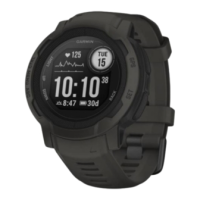

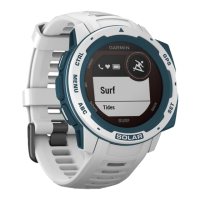
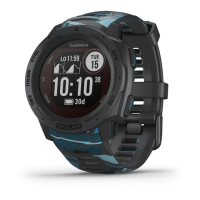


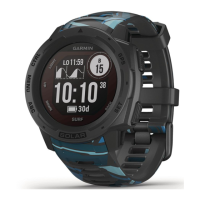
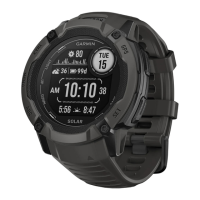
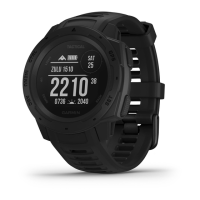
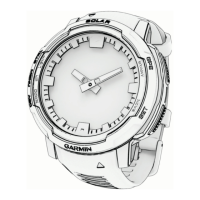
